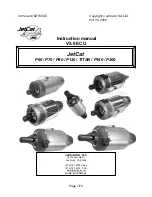
70
Inhibiting
WARNING! Observe the following rules when
cleaning with high-pressure water jets. Never di-
rect the water jet at seals, rubber hoses or electri-
cal components. Never use a high pressure jet
when washing the engine.
7.
Check that the batteries are kept well charged. A
discharged battery may easily burst.
Batteries always have a certain amount of self-
discharge which increases the higher the tempera-
ture. Batteries in storage should therefore be kept
as cool as possible. The should be stored dry and
clean and normally charged when the electrolyte
density drops below 1.24 g/cm
3
(1.20 g/cm
3
for
batteries with tropical acid).
Preferably remove the batteries and hand them in
for maintenance charging as instructed by the
manufacturer.
See also point 2 under “Electrical System –
Important” on page 61.
8.
When necessary, improve the external rust protec-
tion by brushing on anti-corrosion oil. The surfaces
should be clean and dry before being treated.
NOTE! Certain engine conservation oils are
inflammable. Some of them are also danger-
ous if inhaled. Ensure that ventilation in the
work place is good. Use a breathing mask
when spraying.
9.
Stick a decal on the engine stating the date of
inhibition, type of inhibition and the inhibiting oil
used.
10. Cover engine air intake, exhaust pipe outlet and
engine if required.
Launching procedures
Check the condition of the propeller(s). Damaged pro-
pellers should be reconditioned or replaced.
Bringing out of storage
1.
Remove any protective cover over the engine, air
intake and exhaust pipe.
2.
Remove any external inhibitors using white spirit.
3.
Close the drain cocks and fit the drain plugs. Install
the seawater pump impeller using a clockwise
rotating movement.
Fill the freshwater system if the coolant has been
drained. See “Filling coolant” on page 55. For
coolants, refer to page 16.
4.
If necessary, fill the engine with lubricating oil of
the correct quality. Install a new oil filter if this has
not been done when changing the oil during
inhibiting. Check the oil level in the reverse gear.
5.
Check the batteries as described on page 62.
Connect batteries.
6.
Fit new fuel filters and vent the fuel system as
described on pages 51.
7.
Open the sea cock. Start the engine (see “Opera-
tion”) and warm the engine up at a fast idle before
loading the engine.
8.
Check for any leaks of oil, fuel or cooling water.
Boat unused for up to two months
If the boat is not expected to be used for up to two
months, it is sufficient to start the engine and warm it up
once a fortnight.
If there is a danger of freezing, the cooling system’s
seawater circuit should be drained after stopping.
Check/top up the freshwater system’s antifreeze to pre-
vent damage. Empty freshwater tank if fitted.
Remove the drain plug (if fitted) on the exhaust pipe
condensed water collector. Drain the water from any
low-lying parts on the exhaust pipe.
Check the batteries’ charge condition. A discharged bat-
tery may easily burst.
Boat unused for more than two
months
1.
Warm the engine up to normal operating tempera-
ture.
2.
Check that the lubricating oil level in the reverse
gear reaches the upper mark (“FULL”) on the
dipstick. Check the level with the engine idling and
the control in neutral.
3.
Stop the engine and drain or pump the lubricating
oil from the oil sump.
4.
Boat unused max. 8 months: Replace the
lubricating oil filter and fill with Volvo Penta lubri-
cating oil to the normal level. Warm the engine up
after changing the oil.
5.
Boat unused for more than 8 months: Fill the
engine with inhibiting oil to just above the lower
part of the mark on the dipstick. The oil companies
sell inhibiting oil.
Connect the fuel lines (suction and return) to a can
filled with 1/3 inhibiting oil and 2/3 diesel. Some oil
companies sell a ready-mixed oil for this purpose.
Vent the fuel system according to the instructions
on page 51. Start the engine and run on fast idle
until approx. 2 liters have been used from the can.
Stop the engine and drain or pump the lubricating
oil from the oil sump. Connect the regular fuel
lines.
6.
Check that the coolant in the freshwater system
has sufficient antifreeze and top up if required. Or
drain the coolant. Close the sea cock and drain the
water from the seawater system. See page 24.
Remove the seawater pump impeller.
Summary of Contents for TAMD162C
Page 1: ...INSTRUCTIONBOOK TAMD162C TAMD163A TAMD163P ...
Page 2: ......
Page 82: ...80 Notes ...
Page 83: ......
Page 84: ...7737387 6 English 8 1998 ...













































